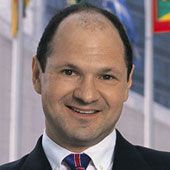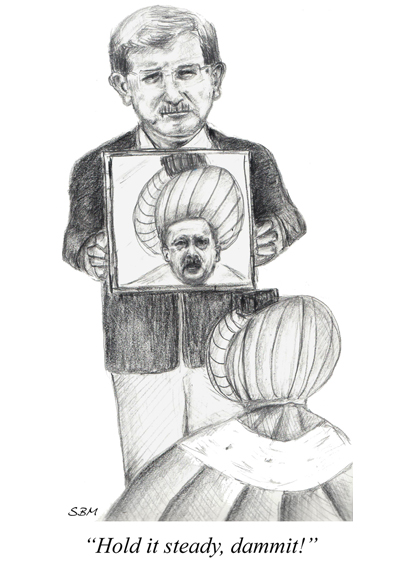What Contemporary Art Tells Us About Trump
Art has an uncanny ability to predict the future.
May 23, 2016
Art has an uncanny ability to predict the future. It is perhaps because at some intuitive level creative artists can sense deep undercurrents in society that remain concealed from more conventional observers, professional analysts and politicians.
For example, Northern European – and especially German – expressionist painters began creating their highly emotional, anxiety-ridden and even frightening images amidst the peace and tranquility of the early 20th century.
Edvard Munch’s famous “The Scream” that seems to react to the horrors of World War I and its aftermath, was actually painted in 1893, more than two decades before the Guns of August went into action.
Many of the German works that followed seem to come out of the trench warfare and reflect the postwar rage at imbecile generals, self-serving politicians and cynical war profiteers, but actually predate and presage all that.
The Futurists in Italy also predated the emergence of fascism, just as Constructivism appeared in Russia before the Bolshevik takeover.
Both glorified the machine and proposed that society be organized along the lines of the machine age, with humans stripped of their individuality and made to serve some higher purpose with their highly regimented lives.
Both essentially rejected liberal concerns with the uniqueness of human life and development of the individual.
Trump’s rise predicted by artwork?
Since the rise of Donald Trump at the start of the 2016 Presidential campaign, pundits have expressed surprise at his emergence, filling the airwaves, the internet and the pages of the remaining print publications with speculation how he managed to sneak under their radar.
However, his rise has been predicted for years – not by the talking heads on cable news stations, but by artists showing in art galleries in Chelsea and newly trendy Brooklyn.
Last week I went to hear Janine Antoni, a major contemporary artist. It was a lecture in conjunction with the Unfinished exhibition put on by the Metropolitan Museum of Art at its new Met Breuer venue. (For the sake of disclosure I have to reveal that my wife is a co-curator of the exhibition.)
Ms. Antoni has a piece in the show, a fragment of her 1993 work for the Venice Biennale titled “Lick and Lather.” The work consists of seven identical soap and seven identical chocolate busts of the artist, produced mechanically by making the mold of her upper torso.
Once the busts were cast, the artist licked the chocolate and washed herself with the soap, resulting in various stages of degradation of the original casts.
Miss Antoni talked about the work and then discussed her other projects – sculpture, photography and performance art – which she undertook in the course of an artistic career spanning more than a quarter of a century.
They included portraits of her mother and father dressed as each other, a picture of the artist bathing in a trough on a farm, being licked by a cow which is trying to get to the water, another picture of the artist’s baby sticking a feeding spoon into her mother’s navel.
What is contemporary art?
Miss Antoni works in the mainstream of contemporary art and most of contemporary artists work in the same vein. First and foremost, their art is narcissistic.
It is all about the artist, his or her personality, experiences and earthy existence. While it often involves a product – even though in some cases it is ephemeral and in many conceptual or performance pieces there is no product at all – the focus is on the artist or, at most, the process.
Secondly, contemporary art is not only unconcerned with craft but is actually contemptuous of it. Artists not only can no longer do any of the things that constituted artistic skills in previous generations – i.e., draw, paint or sculpt – but take pride in their inability to do so.
Miss Antoni creates sculpture, but the process is mechanical. Artists like the late Jean-Michel Basquiat actually boast of this with helpless doodles they produce on their canvas when they actually attempt to draw something. Traditional skills are not only lost but deliberately discarded.
Thirdly, contemporary art is simple-minded – once again, deliberately so. It uses as its primary material raw, unprocessed and unmediated sensations of the artists, including but not limited to their physiological functions, sexual preferences and the like, making no attempt to disguise them behind any intellectual veneer.
The similarities
A brilliant piece by Miss Antoni titled “Loving Care” (1993) consists of the artist dipping her gorgeous long hair in black dye and mopping the floor of the gallery by thrashing about.
Since it is a performance piece and it involves viewers, the artist gradually pushes them out, taking over their space. The inspiration for the piece, according to the artist, was her mother mopping the kitchen floor and sending little Janine out into the yard.
Project the contemporary visual art onto, say, literature, and you have a novel without a narrative or with broken narrative, written with utter contempt for grammar, syntax and spelling and containing a bunch of platitudes, pop culture allusions, insider jokes and diary-like personal experiences.
Contemporary art is very much about money. You can buy an original etching by a major artists for a few thousand dollars. Second-tier Old Master paintings will set you back a few hundred thousands, or couple of million at most. Established contemporary art is priced well above. Basquiat’s paintings run into tens of millions.
Finally, contemporary art is about publicity. Without very skillful self-promotion – and promotion by the PR machinery that serves the art establishment – there would be no contemporary art.
Finally, contemporary art it much more popular than any other kind of art. While Ph.D. programs may be different, Master’s students are predominantly interested in studying, viewing and working with contemporary artists.
If you substitute the words “contemporary art” for “Donald Trump” you’ll get a perfect picture. Trump is a self-indulgent narcissist, he doesn’t give a hoot for professional aspects of politics, his political program is trite and simple-minded and his language, requires the level of comprehension of a third-grader.
Trump is no fluke
Trump is all about money, too: his own personal wealth is a major part of his appeal. His self-promotion and his ability to use the media as his own PR machine is second to none.
Trump’s emergence is not a fluke. It was foreshadowed by contemporary art and he did not arrive in a vacuum.
He was preceded by Sarah Palin, a wholly unconventional politician who shares most of Trump’s characteristics except she is not as skilled a performer and is not at all rich. Still, her rise as a national figure in 2008 was the harbinger of things to come.
I must confess I never had much appreciation for contemporary art. My reaction to most expensive objects and best performance pieces has usually ranged from boredom to disgust.
I suspect I’m not alone. Now, thanks to Trump I’m starting to see it in a completely new light. Taken together – it is not necessarily to distinguish between individual artists since contemporary art is a synthetic, collective, fluid and homogenous endeavor, in which the manufacturing of the individual star is random and arbitrary. It is brilliant commentary on our times, it’s leaders and its foibles.

